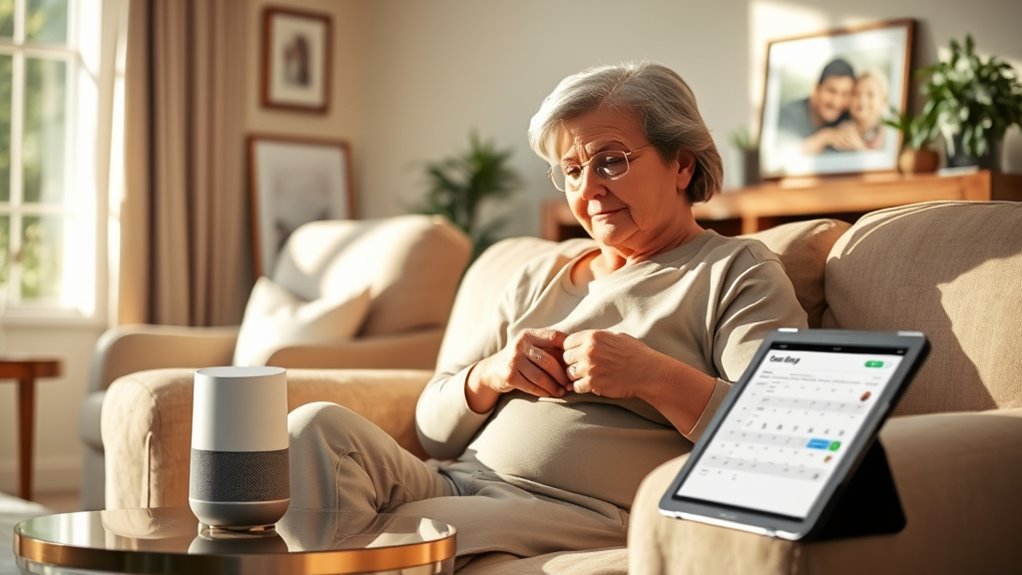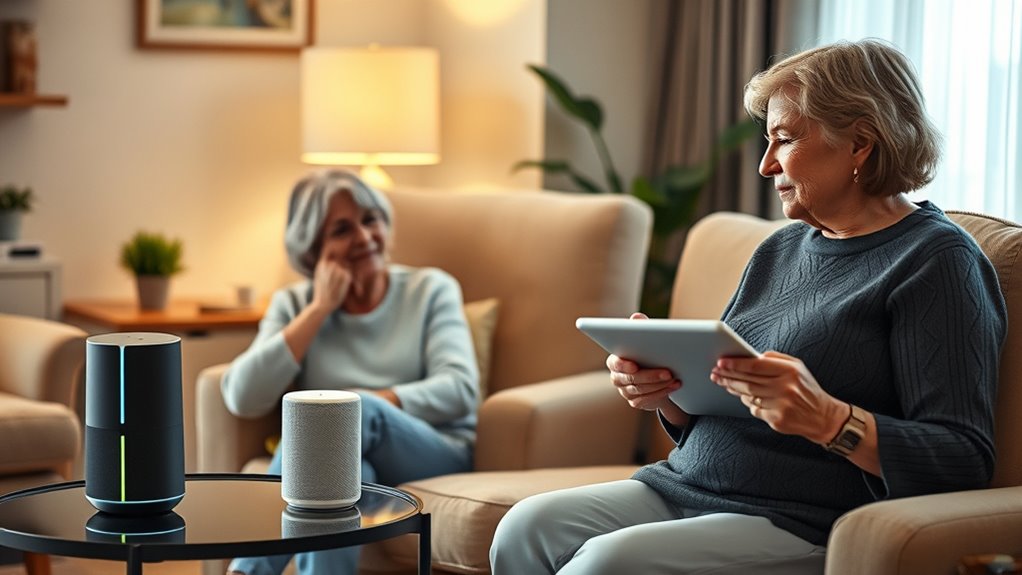As a caregiver, you rely on voice assistants to manage medication reminders, organize shopping lists, and set household timers with simple commands like “Remind me to give medication at 8 a.m.” You can quickly access health information, contact emergency services, and even control vehicle settings for travel. These tools help you stay organized, guarantee safety, and save time. Keep exploring how voice commands can make your caregiving tasks easier and more efficient.
Key Takeaways
- Caregivers frequently use voice commands to set medication reminders and receive alerts to ensure timely dosing.
- Voice assistants help organize shopping lists and household chores, simplifying task management.
- Quick access to health information, like medication effects or care instructions, is a common voice command.
- Emergency commands, such as calling 911 or healthcare providers, are vital for immediate response.
- Voice assistants support travel with vehicle settings, navigation, and routine reminders during caregiving trips.

Voice assistants are transforming the way caregivers manage their daily tasks by providing instant access to information, reminders, and support. When you’re juggling multiple responsibilities, having a reliable voice-activated tool can make a significant difference. Instead of fumbling through your phone or flipping through paper notes, you can speak directly to your device and get immediate assistance. Whether you’re coordinating medication schedules, tracking appointments, or managing household chores, voice assistants streamline these activities, saving you valuable time and reducing stress.
You might find yourself asking your voice assistant to set reminders for medication times. Instead of trying to remember if you gave your loved one their pill, you simply say, “Remind me to give the medication at 8 a.m.,” and the device takes care of the rest. When it’s time, you’ll get a clear alert, ensuring nothing gets missed. This hands-free approach means you stay focused on caregiving tasks without interruption. You can also ask your assistant to create shopping lists for supplies, so next time you’re at the store, you have an organized list ready. Just say, “Add milk and bread to the shopping list,” and it’s stored for easy access later.
Getting quick answers is another common command. If you’re unsure about medication interactions or care instructions, you can ask, “What are the side effects of this medication?” or “How do I care for a pressure ulcer?” Voice assistants can provide concise, dependable information, helping you make informed decisions swiftly. This immediate access supports your role as a caregiver, especially during emergencies or when you’re pressed for time.
Managing household routines is also simplified. You can ask your device to set timers while cooking or to remind you of upcoming appointments. For example, “Set a timer for 20 minutes,” helps you keep track of medication or food preparation without stopping what you’re doing. If you need to contact a healthcare provider or emergency services, many voice assistants can do that with a simple voice command, such as, “Call 911” or “Contact Dr. Smith.” This quick access can be imperative in urgent situations.
Additionally, with Mazda Tuning, drivers can customize their vehicle’s performance to better suit their needs, which can be particularly helpful during long caregiving trips or commutes.
Frequently Asked Questions
How Do Voice Assistants Ensure Patient Privacy and Data Security?
Voice assistants protect patient privacy by encrypting data during transmission and storage. They use secure authentication methods, like passwords or biometrics, to restrict access. Regular updates patch security vulnerabilities, and access logs track who used the system and when. You can also customize permissions to limit data sharing, ensuring sensitive information stays protected. These measures help you maintain confidentiality while benefiting from voice-controlled assistance.
Can Voice Assistants Understand Regional Accents and Dialects?
Yes, voice assistants can understand regional accents and dialects, but their accuracy varies. Developers continually improve their algorithms to better recognize diverse speech patterns. You can enhance understanding by speaking clearly and slowly. Some assistants allow you to customize settings or train the system with your voice. While they’re not perfect yet, advances in machine learning are making them more effective at understanding regional language variations, making them more useful in real-world situations.
What Is the Cost of Implementing Voice Assistant Technology?
The cost of implementing voice assistant technology varies widely based on features and scale. You might spend a few hundred dollars for basic devices, but enterprise solutions or custom integrations can cost thousands or more. Factors like hardware, software development, and ongoing maintenance influence expenses. You should also consider training staff and ensuring compatibility with existing systems. Planning your budget carefully helps you get the most value from your investment.
How Do Voice Assistants Handle Emergency Situations?
When an emergency occurs, voice assistants can quickly recognize your commands and alert emergency services or designated contacts. You simply say a specific phrase like “Help” or “Emergency,” and the device automatically contacts responders or family members. Some systems even provide step-by-step instructions for first aid or guide you through the situation. This instant response helps guarantee safety, making it easier for you to get immediate assistance when it’s most needed.
Are Voice Assistants Compatible With Existing Medical Devices?
Think of voice assistants as bridges connecting you to medical devices. Many are compatible, allowing you to control or monitor devices through simple commands. However, compatibility varies by device and manufacturer, so you need to check each one’s specifications. You’ll find that some integrations are seamless, like a well-oiled machine, while others may require additional setups or updates. Always verify before relying on voice commands for critical medical functions.
Conclusion
Voice assistants become your silent partners, seamlessly fitting into your daily routine. They listen, respond, and lighten your load—turning chaos into calm with a simple command. As you navigate the demands of caregiving, these tools are more than gadgets; they’re your trusted allies. Embrace their help, and watch how they transform your day—one command at a time. Because in this dance of care, a voice assistant isn’t just a tool—it’s your steady rhythm.









